Josef Sivic
Language-Guided Music Recommendation for Video via Prompt Analogies
Jun 15, 2023Abstract:We propose a method to recommend music for an input video while allowing a user to guide music selection with free-form natural language. A key challenge of this problem setting is that existing music video datasets provide the needed (video, music) training pairs, but lack text descriptions of the music. This work addresses this challenge with the following three contributions. First, we propose a text-synthesis approach that relies on an analogy-based prompting procedure to generate natural language music descriptions from a large-scale language model (BLOOM-176B) given pre-trained music tagger outputs and a small number of human text descriptions. Second, we use these synthesized music descriptions to train a new trimodal model, which fuses text and video input representations to query music samples. For training, we introduce a text dropout regularization mechanism which we show is critical to model performance. Our model design allows for the retrieved music audio to agree with the two input modalities by matching visual style depicted in the video and musical genre, mood, or instrumentation described in the natural language query. Third, to evaluate our approach, we collect a testing dataset for our problem by annotating a subset of 4k clips from the YT8M-MusicVideo dataset with natural language music descriptions which we make publicly available. We show that our approach can match or exceed the performance of prior methods on video-to-music retrieval while significantly improving retrieval accuracy when using text guidance.
Vid2Seq: Large-Scale Pretraining of a Visual Language Model for Dense Video Captioning
Mar 21, 2023



Abstract:In this work, we introduce Vid2Seq, a multi-modal single-stage dense event captioning model pretrained on narrated videos which are readily-available at scale. The Vid2Seq architecture augments a language model with special time tokens, allowing it to seamlessly predict event boundaries and textual descriptions in the same output sequence. Such a unified model requires large-scale training data, which is not available in current annotated datasets. We show that it is possible to leverage unlabeled narrated videos for dense video captioning, by reformulating sentence boundaries of transcribed speech as pseudo event boundaries, and using the transcribed speech sentences as pseudo event captions. The resulting Vid2Seq model pretrained on the YT-Temporal-1B dataset improves the state of the art on a variety of dense video captioning benchmarks including YouCook2, ViTT and ActivityNet Captions. Vid2Seq also generalizes well to the tasks of video paragraph captioning and video clip captioning, and to few-shot settings. Our code is publicly available at https://antoyang.github.io/vid2seq.html.
MegaPose: 6D Pose Estimation of Novel Objects via Render & Compare
Dec 13, 2022



Abstract:We introduce MegaPose, a method to estimate the 6D pose of novel objects, that is, objects unseen during training. At inference time, the method only assumes knowledge of (i) a region of interest displaying the object in the image and (ii) a CAD model of the observed object. The contributions of this work are threefold. First, we present a 6D pose refiner based on a render&compare strategy which can be applied to novel objects. The shape and coordinate system of the novel object are provided as inputs to the network by rendering multiple synthetic views of the object's CAD model. Second, we introduce a novel approach for coarse pose estimation which leverages a network trained to classify whether the pose error between a synthetic rendering and an observed image of the same object can be corrected by the refiner. Third, we introduce a large-scale synthetic dataset of photorealistic images of thousands of objects with diverse visual and shape properties and show that this diversity is crucial to obtain good generalization performance on novel objects. We train our approach on this large synthetic dataset and apply it without retraining to hundreds of novel objects in real images from several pose estimation benchmarks. Our approach achieves state-of-the-art performance on the ModelNet and YCB-Video datasets. An extensive evaluation on the 7 core datasets of the BOP challenge demonstrates that our approach achieves performance competitive with existing approaches that require access to the target objects during training. Code, dataset and trained models are available on the project page: https://megapose6d.github.io/.
Multi-Task Learning of Object State Changes from Uncurated Videos
Nov 24, 2022



Abstract:We aim to learn to temporally localize object state changes and the corresponding state-modifying actions by observing people interacting with objects in long uncurated web videos. We introduce three principal contributions. First, we explore alternative multi-task network architectures and identify a model that enables efficient joint learning of multiple object states and actions such as pouring water and pouring coffee. Second, we design a multi-task self-supervised learning procedure that exploits different types of constraints between objects and state-modifying actions enabling end-to-end training of a model for temporal localization of object states and actions in videos from only noisy video-level supervision. Third, we report results on the large-scale ChangeIt and COIN datasets containing tens of thousands of long (un)curated web videos depicting various interactions such as hole drilling, cream whisking, or paper plane folding. We show that our multi-task model achieves a relative improvement of 40% over the prior single-task methods and significantly outperforms both image-based and video-based zero-shot models for this problem. We also test our method on long egocentric videos of the EPIC-KITCHENS and the Ego4D datasets in a zero-shot setup demonstrating the robustness of our learned model.
Benchmarking Learning Efficiency in Deep Reservoir Computing
Sep 29, 2022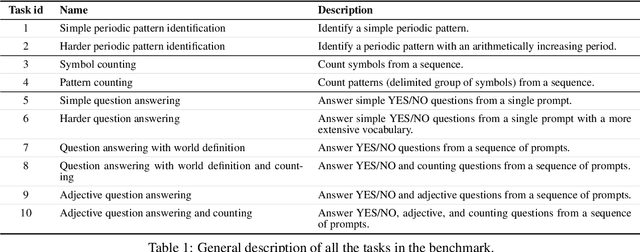



Abstract:It is common to evaluate the performance of a machine learning model by measuring its predictive power on a test dataset. This approach favors complicated models that can smoothly fit complex functions and generalize well from training data points. Although essential components of intelligence, speed and data efficiency of this learning process are rarely reported or compared between different candidate models. In this paper, we introduce a benchmark of increasingly difficult tasks together with a data efficiency metric to measure how quickly machine learning models learn from training data. We compare the learning speed of some established sequential supervised models, such as RNNs, LSTMs, or Transformers, with relatively less known alternative models based on reservoir computing. The proposed tasks require a wide range of computational primitives, such as memory or the ability to compute Boolean functions, to be effectively solved. Surprisingly, we observe that reservoir computing systems that rely on dynamically evolving feature maps learn faster than fully supervised methods trained with stochastic gradient optimization while achieving comparable accuracy scores. The code, benchmark, trained models, and results to reproduce our experiments are available at https://github.com/hugcis/benchmark_learning_efficiency/ .
Imitrob: Imitation Learning Dataset for Training and Evaluating 6D Object Pose Estimators
Sep 19, 2022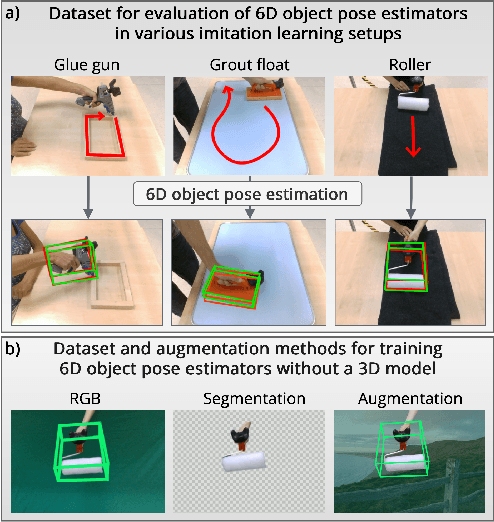

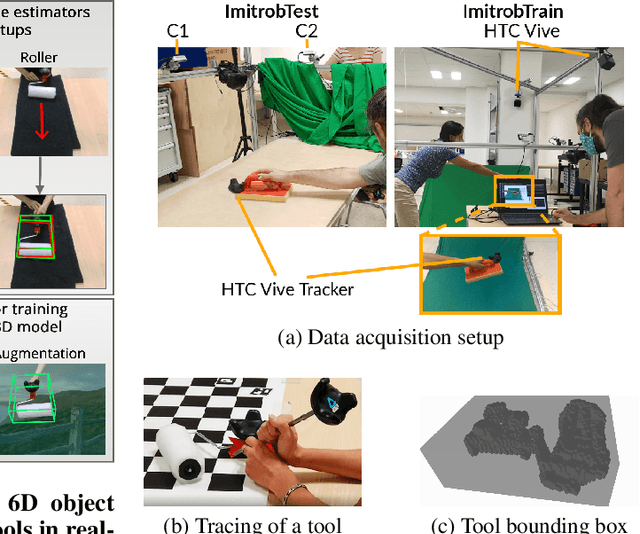
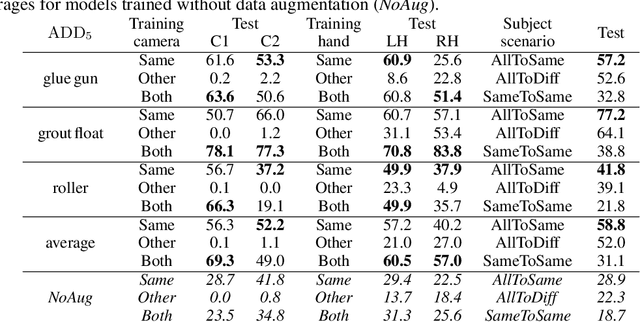
Abstract:This paper introduces a dataset for training and evaluating methods for 6D pose estimation of hand-held tools in task demonstrations captured by a standard RGB camera. Despite the significant progress of 6D pose estimation methods, their performance is usually limited for heavily occluded objects, which is a common case in imitation learning where the object is typically partially occluded by the manipulating hand. Currently, there is a lack of datasets that would enable the development of robust 6D pose estimation methods for these conditions. To overcome this problem, we collect a new dataset (Imitrob) aimed at 6D pose estimation in imitation learning and other applications where a human holds a tool and performs a task. The dataset contains image sequences of three different tools and six manipulation tasks with two camera viewpoints, four human subjects, and left/right hand. Each image is accompanied by an accurate ground truth measurement of the 6D object pose, obtained by the HTC Vive motion tracking device. The use of the dataset is demonstrated by training and evaluating a recent 6D object pose estimation method (DOPE) in various setups. The dataset and code are publicly available at http://imitrob.ciirc.cvut.cz/imitrobdataset.php.
Differentiable Collision Detection: a Randomized Smoothing Approach
Sep 19, 2022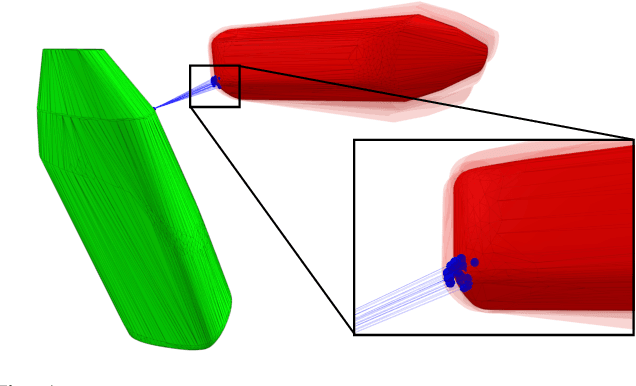
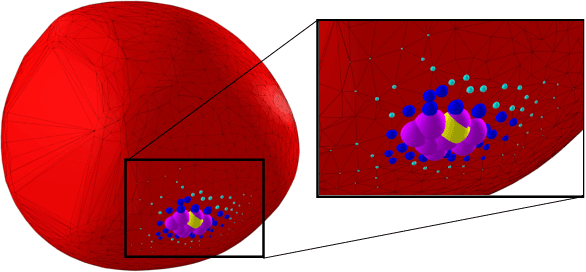
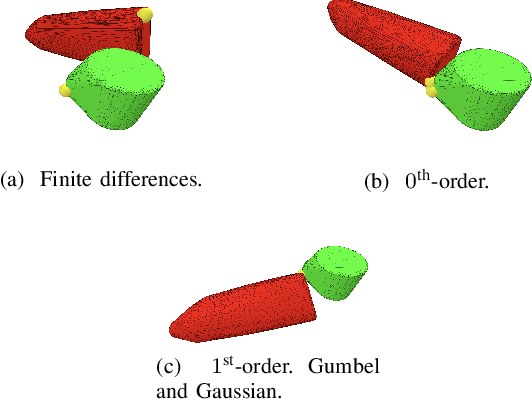
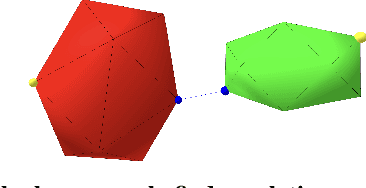
Abstract:Collision detection appears as a canonical operation in a large range of robotics applications from robot control to simulation, including motion planning and estimation. While the seminal works on the topic date back to the 80s, it is only recently that the question of properly differentiating collision detection has emerged as a central issue, thanks notably to the ongoing and various efforts made by the scientific community around the topic of differentiable physics. Yet, very few solutions have been suggested so far, and only with a strong assumption on the nature of the shapes involved. In this work, we introduce a generic and efficient approach to compute the derivatives of collision detection for any pair of convex shapes, by notably leveraging randomized smoothing techniques which have shown to be particularly adapted to capture the derivatives of non-smooth problems. This approach is implemented in the HPP-FCL and Pinocchio ecosystems, and evaluated on classic datasets and problems of the robotics literature, demonstrating few micro-second timings to compute informative derivatives directly exploitable by many real robotic applications including differentiable simulation.
Learning Object Manipulation Skills from Video via Approximate Differentiable Physics
Aug 03, 2022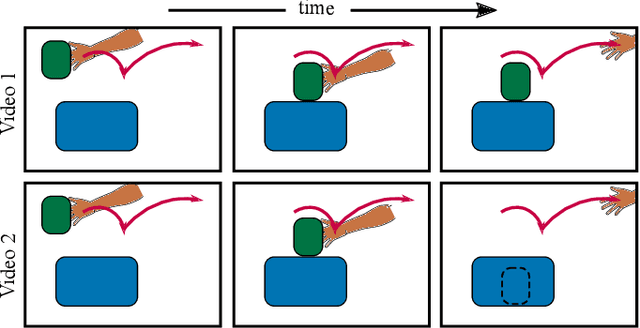
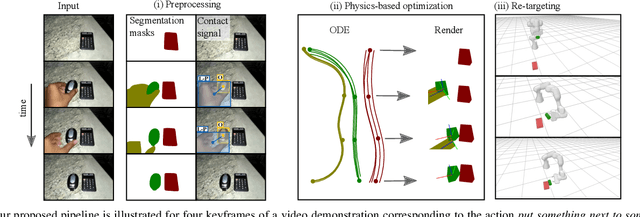
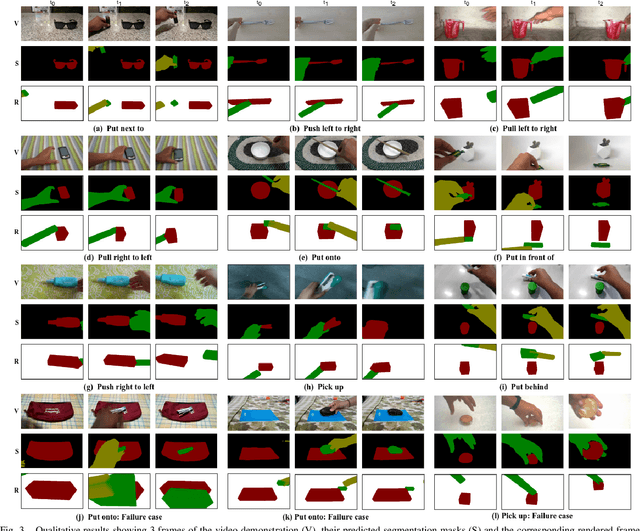

Abstract:We aim to teach robots to perform simple object manipulation tasks by watching a single video demonstration. Towards this goal, we propose an optimization approach that outputs a coarse and temporally evolving 3D scene to mimic the action demonstrated in the input video. Similar to previous work, a differentiable renderer ensures perceptual fidelity between the 3D scene and the 2D video. Our key novelty lies in the inclusion of a differentiable approach to solve a set of Ordinary Differential Equations (ODEs) that allows us to approximately model laws of physics such as gravity, friction, and hand-object or object-object interactions. This not only enables us to dramatically improve the quality of estimated hand and object states, but also produces physically admissible trajectories that can be directly translated to a robot without the need for costly reinforcement learning. We evaluate our approach on a 3D reconstruction task that consists of 54 video demonstrations sourced from 9 actions such as pull something from right to left or put something in front of something. Our approach improves over previous state-of-the-art by almost 30%, demonstrating superior quality on especially challenging actions involving physical interactions of two objects such as put something onto something. Finally, we showcase the learned skills on a Franka Emika Panda robot.
Zero-Shot Video Question Answering via Frozen Bidirectional Language Models
Jun 16, 2022
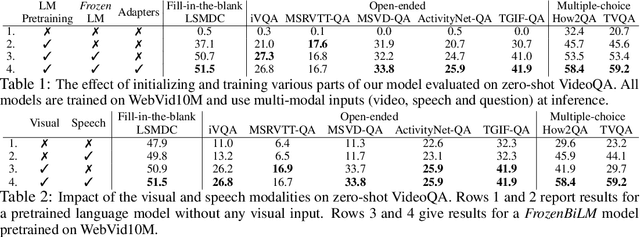
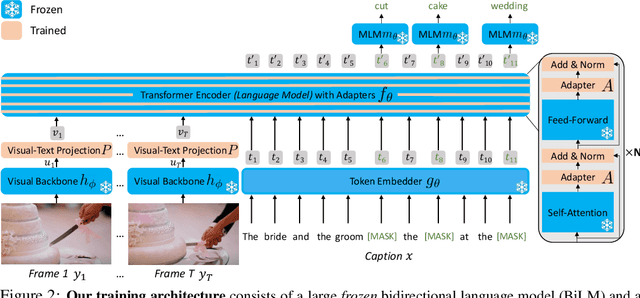

Abstract:Video question answering (VideoQA) is a complex task that requires diverse multi-modal data for training. Manual annotation of question and answers for videos, however, is tedious and prohibits scalability. To tackle this problem, recent methods consider zero-shot settings with no manual annotation of visual question-answer. In particular, a promising approach adapts frozen autoregressive language models pretrained on Web-scale text-only data to multi-modal inputs. In contrast, we here build on frozen bidirectional language models (BiLM) and show that such an approach provides a stronger and cheaper alternative for zero-shot VideoQA. In particular, (i) we combine visual inputs with the frozen BiLM using light trainable modules, (ii) we train such modules using Web-scraped multi-modal data, and finally (iii) we perform zero-shot VideoQA inference through masked language modeling, where the masked text is the answer to a given question. Our proposed approach, FrozenBiLM, outperforms the state of the art in zero-shot VideoQA by a significant margin on a variety of datasets, including LSMDC-FiB, iVQA, MSRVTT-QA, MSVD-QA, ActivityNet-QA, TGIF-FrameQA, How2QA and TVQA. It also demonstrates competitive performance in the few-shot and fully-supervised setting. Our code and models will be made publicly available at https://antoyang.github.io/frozenbilm.html.
Collision Detection Accelerated: An Optimization Perspective
May 20, 2022
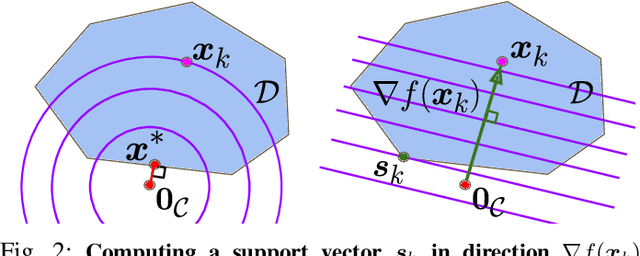
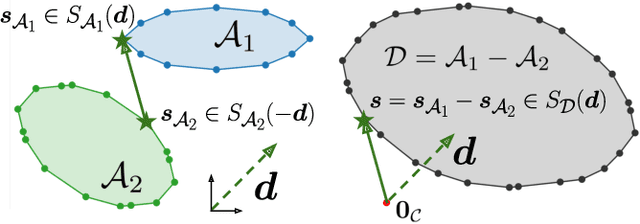

Abstract:Collision detection between two convex shapes is an essential feature of any physics engine or robot motion planner. It has often been tackled as a computational geometry problem, with the Gilbert, Johnson and Keerthi (GJK) algorithm being the most common approach today. In this work we leverage the fact that collision detection is fundamentally a convex optimization problem. In particular, we establish that the GJK algorithm is a specific sub-case of the well-established Frank-Wolfe (FW) algorithm in convex optimization. We introduce a new collision detection algorithm by adapting recent works linking Nesterov acceleration and Frank-Wolfe methods. We benchmark the proposed accelerated collision detection method on two datasets composed of strictly convex and non-strictly convex shapes. Our results show that our approach significantly reduces the number of iterations to solve collision detection problems compared to the state-of-the-art GJK algorithm, leading to up to two times faster computation times.
* RSS 2022, 12 pages, 9 figures, 2 tables
 Add to Chrome
Add to Chrome Add to Firefox
Add to Firefox Add to Edge
Add to Edge